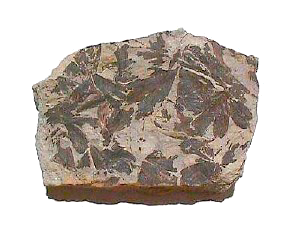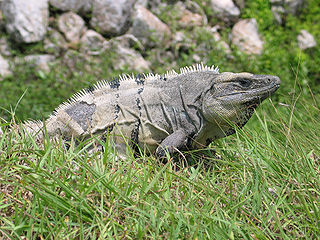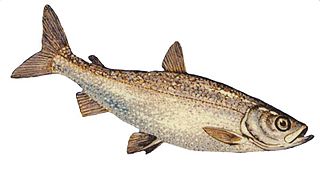Related Research Articles

Herring are forage fish, mostly belonging to the family Clupeidae.

Carp are various species of oily freshwater fish from the family Cyprinidae, a very large group of fish native to Europe and Asia. While carp is consumed in many parts of the world, they are generally considered an invasive species in parts of Africa, Australia and most of the United States.

The Ginkgoaceae is a family of gymnosperms which appeared during the Mesozoic Era, of which the only extant representative is Ginkgo biloba, which is for this reason sometimes regarded as a living fossil. Formerly, however, there were several other genera, and forests of ginkgo existed. Because leaves can take such diverse forms within a single species, these are a poor measure of diversity, although differing structures of wood point to the existence of diverse ginkgo forests in ancient times.

"Sardine" and "pilchard" are common names that refer to various small, oily forage fish in the herring family Clupeidae. The term "sardine" was first used in English during the early 15th century and may come from the Mediterranean island of Sardinia, around which sardines were once abundant.

Ctenosaura is a lizard genus commonly known as spinytail iguanas or ctenosaurs. The genus is part of the large lizard family, Iguanidae and is native to Mexico and Central America. The name is derived from two Greek words: ctenos (κτενός), meaning "comb", and saura (σαύρα), meaning "lizard".

Gadus is a genus of demersal fish in the family Gadidae, commonly known as cod, although there are additional cod species in other genera. The best known member of the genus is the Atlantic cod.

The Integrated Taxonomic Information System (ITIS) is an American partnership of federal agencies designed to provide consistent and reliable information on the taxonomy of biological species. ITIS was originally formed in 1996 as an interagency group within the US federal government, involving several US federal agencies, and has now become an international body, with Canadian and Mexican government agencies participating. The database draws from a large community of taxonomic experts. Primary content staff are housed at the Smithsonian National Museum of Natural History and IT services are provided by a US Geological Survey facility in Denver. The primary focus of ITIS is North American species, but many biological groups exist worldwide and ITIS collaborates with other agencies to increase its global coverage.

The Acrochordidae, commonly known as wart snakes, Java wart snakes, file snakes, elephant trunk snakes, or dogface snakes are a monogeneric family created for the genus Acrochordus. This is a group of primitive aquatic snakes found in Australia and tropical Asia. Currently, three species are recognized.

Loxocemus bicolor, sole member of the monotypic family Loxocemidae, is a species of python-like snake found in Mexico and Central America. No subspecies are currently recognized. Analyses of DNA show that Loxocemus is most closely related to the true pythons and the sunbeam snakes.

Xenopeltis the sunbeam snakes, are the sole genus of the monotypic family Xenopeltidae, the species of which are found in Southeast Asia. Sunbeam snakes are known for their highly iridescent scales. Currently, two species are recognized. Studies of DNA suggest that the xenopeltids are most closely related to the Mexican burrowing python, Loxocemus bicolor, and to the true pythons of Pythonidae.

Slipper lobsters are a family (Scyllaridae) of about 90 species of achelate crustaceans, in the Decapoda clade Reptantia, found in all warm oceans and seas. They are not true lobsters, but are more closely related to spiny lobsters and furry lobsters. Slipper lobsters are instantly recognisable by their enlarged antennae, which project forward from the head as wide plates. All the species of slipper lobsters are edible, and some, such as the Moreton Bay bug and the Balmain bug are of commercial importance.

The freshwater whitefish are fishes of the subfamily Coregoninae, which contains whitefishes and ciscoes, and is one of three subfamilies in the salmon family Salmonidae. Apart from the subfamily Coregoninae, the family Salmonidae includes the salmon, trout, and char species of the subfamily Salmoninae, and grayling species of the subfamily Thymallinae. Freshwater whitefish are distributed mainly in relatively cool waters throughout the northern parts of the Northern Hemisphere.
Atlantasellus is a genus of crustaceans, and the only member of the family Atlantasellidae. It contains these species:
Taeniacanthidae is a family of cyclopoid copepods in the order Cyclopoida. There are more than 20 genera and 120 described species in Taeniacanthidae.

An anchovy is a small, common forage fish of the family Engraulidae. Most species are found in marine waters, but several will enter brackish water, and some in South America are restricted to fresh water.
Cardus crucifer is a species of blind deep-water decapod crustacean from the Atlantic Ocean, the only species in the genus Cardus. It differs from other members of the family Polychelidae in having only four pairs of claws, instead of five, in both sexes. The name Cardus refers to the thistle Carduus, in reference to the spiny thistle-like carapace. It is found in the eastern Atlantic from Portugal to Morocco and around the Azores and Canary Islands, and in the Bahamas, the Caribbean Sea and the Gulf of Mexico, at depths of 550–2,200 metres (1,800–7,220 ft).

The sand worm snake is a species of snake in the Typhlopidae family.
The Madagascar worm snake is a species of snakes in the Typhlopidae family.
In the 10th edition of Systema Naturae, Carl Linnaeus classified the arthropods, including insects, arachnids and crustaceans, among his class "Insecta". Wingless arthropods were brought together under the name Aptera.
Species 2000 is a federation of database organizations across the world that compiles the Catalogue of Life, a comprehensive checklist of the world's species, in partnership with the Integrated Taxonomic Information System (ITIS). The creation of Species 2000 was initiated by Frank Bisby and colleagues at the University of Reading in the UK in 1997 and the Catalogue of Life was first published in 2001. While administrators and member organizations of Species 2000 are located across the world, the secretariat is located at the Naturalis Biodiversity Center in Leiden, Netherlands.
References
- ↑ "Tuccidae Vervoort, 1962". Integrated Taxonomic Information System . Retrieved August 2, 2011.
- ↑ "Tucca Krøyer, 1837". Integrated Taxonomic Information System . Retrieved August 2, 2011.
- ↑ T. Chad Walter & Geoff Boxshall, ed. (2009). "Tuccidae". World Copepoda database. World Register of Marine Species . Retrieved January 25, 2010.